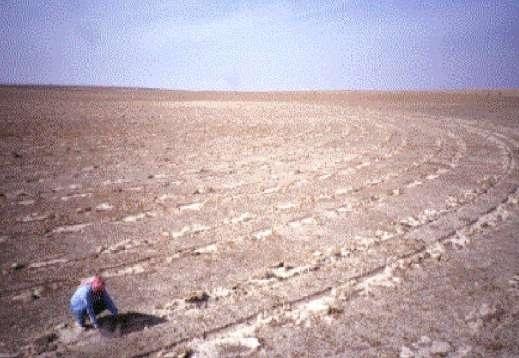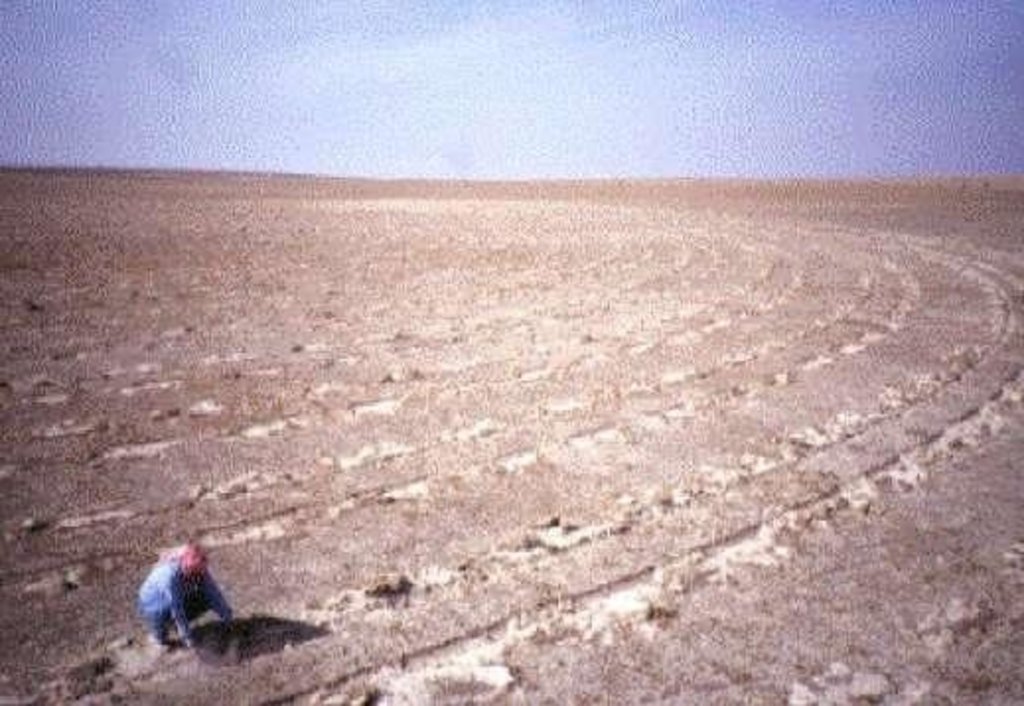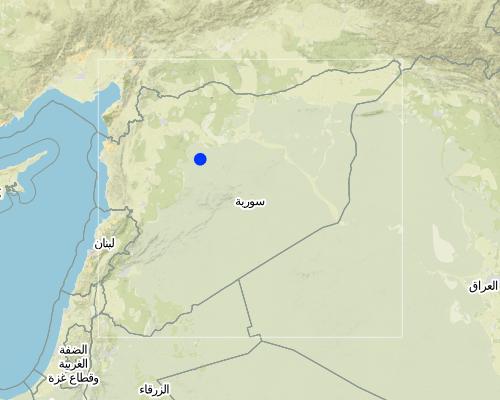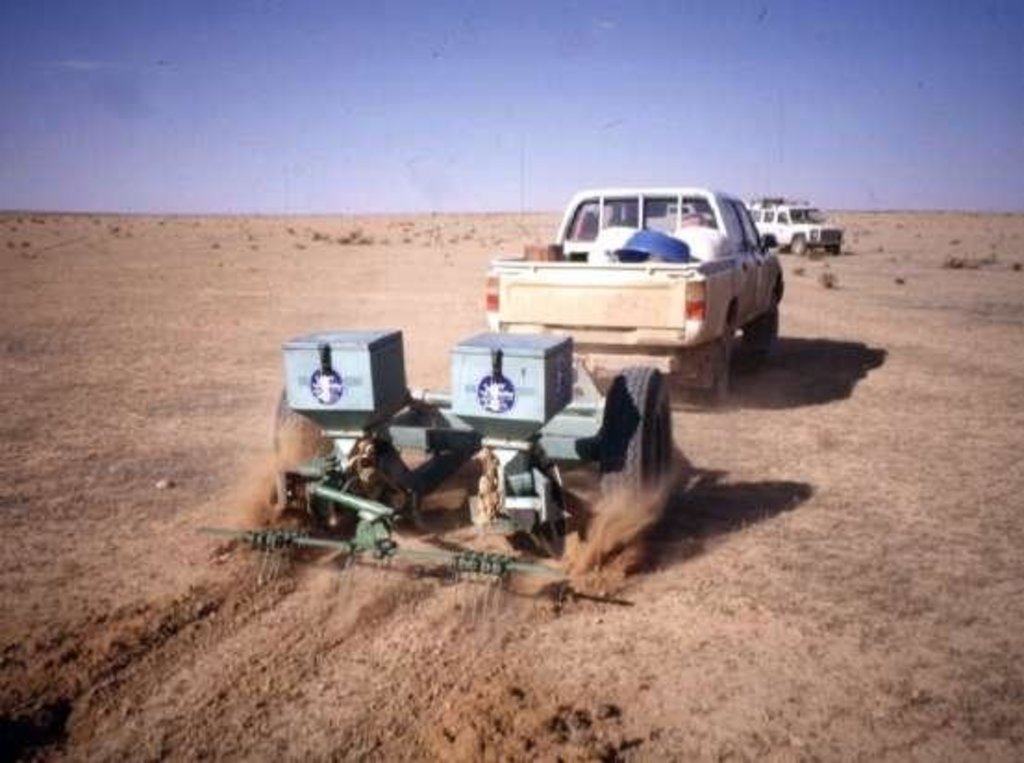Range Pitting and Reseeding [Syrian Arab Republic]
- Creation:
- Update:
- Compiler: Fahim Ghassali
- Editor: –
- Reviewer: Fabian Ottiger
Nakr al mara
technologies_1410 - Syrian Arab Republic
View sections
Expand all Collapse all1. General information
1.2 Contact details of resource persons and institutions involved in the assessment and documentation of the Technology
SLM specialist:
Bathika Nabil
ICARDA
P.O.Box 5466, Aleppo, Syria
Syrian Arab Republic
SLM specialist:
Gintzburger Gustave
+33 3 68 85 00 00
Institut de Botanique -Univ. Louis Pasteur
4 Rue Blaise Pascal, 67081 Strasbourg
France
SLM specialist:
Hill Stephen
Australian Revegetation Corporation Ltd.
Australia
Name of the institution(s) which facilitated the documentation/ evaluation of the Technology (if relevant)
International Center for Agricultural Research in the Dry Areas (ICARDA) - LebanonName of the institution(s) which facilitated the documentation/ evaluation of the Technology (if relevant)
Université de Strasbourg (UNISTRA) - FranceName of the institution(s) which facilitated the documentation/ evaluation of the Technology (if relevant)
Australian Revegetation Corporation Ltd - Australia1.3 Conditions regarding the use of data documented through WOCAT
When were the data compiled (in the field)?
26/08/1999
The compiler and key resource person(s) accept the conditions regarding the use of data documented through WOCAT:
Ja
1.5 Reference to Questionnaire(s) on SLM Approaches
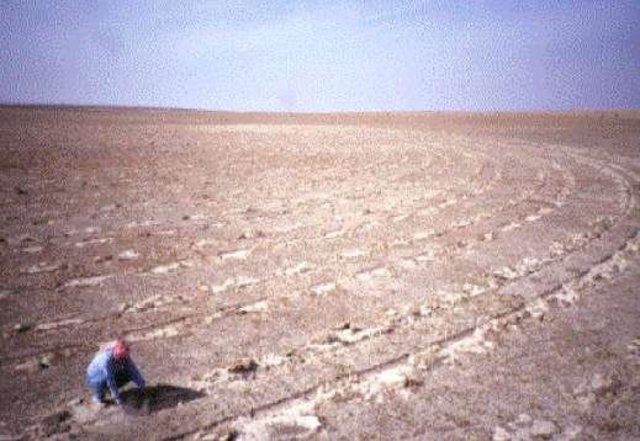
Government assisted rangeland rehabilitation [Syrian Arab Republic]
The rehabilitation of overgrazed and denuded rangeland with government intervention
- Compiler: Unknown User
2. Description of the SLM Technology
2.2 Detailed description of the Technology
Description:
This technique is used to restore degraded rangelands (steppe areas) in the 150-200 mm rainfall zone in Syria. The technique is based on the pitting technique developed in Australia using the 'Camel Pitter' implement. The implement an be towed by an ordinary 2-wheel-drive pickup. Small ahallow 'pits' are scooped out by the action of inclined metal disks (similar to the disks of a disk plough). A seed hopper mounted on the top of the implement releases small quantities of range-plant seeds into the pits and an attached light harrow coveres the seeds with a thin layer of loose topsoil. The implement can also be used without the seeding device. The pits are usually made at the beginning ot just before the rainy season. In the soops made by the implement, rainwater collects and increases the soil moisture storage in and around the pits. On extremely shallow soils, pitting is not recommended because it removes the very top layer of soil and organic surface material and may expose the infertile subsoil. Seeds which emerge in the pits find favourable conditions for emergence and growth. During the early growth stages, the young plants are also sheltered by the pits from wind. The pitting machine should be pulled along the contour to optimize the capture of rainfall. Experience has shown that treating just 10-20 % of the area is sufficient to reestablish a 'starter vegetation' on completely denuded rangeland. In Syria, ARTEMISIA and SALSOLA species have been used successfully for rangeland reseeding. If used without the seeder, the pits will assist the reestablishment of the natural vegetation by providing sheltered and moist sites for seed emergence. To assure optimum reestablishment of vegetation, grazing should be controlled during the initial establishment phase.
2.3 Photos of the Technology
2.5 Country/ region/ locations where the Technology has been applied and which are covered by this assessment
Country:
Syrian Arab Republic
Region/ State/ Province:
Aleppo Province
Further specification of location:
Obisan, Dalbouh
Map
×2.6 Date of implementation
If precise year is not known, indicate approximate date:
- less than 10 years ago (recently)
2.7 Introduction of the Technology
Specify how the Technology was introduced:
- through projects/ external interventions
Comments (type of project, etc.):
Western Australia
3. Classification of the SLM Technology
3.1 Main purpose(s) of the Technology
- reduce, prevent, restore land degradation
3.2 Current land use type(s) where the Technology is applied

Grazing land
Extensive grazing land:
- Nomadism
Comments:
Major land use problems (compiler’s opinion): Overgrazing and cutting of woody shrubs for firewood. Large-scale cultivation of fodder barley (for grazing) completely removes the natural vegetation.
Major land use problems (land users’ perception): The land tenure system. Rangeland is 'public land' and control over its use is difficult to implement.
3.3 Further information about land use
Number of growing seasons per year:
- 1
Specify:
Longest growing period in days: 75 Longest growing period from month to month: Nov - Apr
3.4 SLM group to which the Technology belongs
- improved ground/ vegetation cover
3.5 Spread of the Technology
Comments:
Total area covered by the SLM Technology is 110 m2.
The main collaborator was the Ministry of Agriculture (Steppe Directorate)
3.6 SLM measures comprising the Technology
3.7 Main types of land degradation addressed by the Technology

soil erosion by wind
- Et: loss of topsoil

water degradation
- Ha: aridification
Comments:
Main type of degradation addressed: Et: loss of topsoil, Ha: aridification
Main causes of degradation: overgrazing (Too many animals. Grazing pressure is too high), Over-exploitation of vegetation (Too many animals. Grazing pressure is too high), Land subdivision (Land parcels for communities are limited in size)
3.8 Prevention, reduction, or restoration of land degradation
Specify the goal of the Technology with regard to land degradation:
- prevent land degradation
- restore/ rehabilitate severely degraded land
4. Technical specifications, implementation activities, inputs, and costs
4.1 Technical drawing of the Technology
4.2 Technical specifications/ explanations of technical drawing
Technical knowledge required for field staff / advisors: high
Technical knowledge required for land users: low
Main technical functions: improvement of ground cover, increase / maintain water stored in soil, water harvesting
Vegetative measure: pitting: scooping out very shallow pits
Vegetative material: O : other, O : other
Vegetative measure: Vegetative material: O : other, O : other
Vegetative measure: Vegetative material: O : other, O : other
Vegetative measure: Vegetative material: O : other, O : other
Other species: locally adapted rareseedinspecies, e.g., Atriplex halimus, Salsola vermiculata, Artemisia herba-alba
Gradient along the rows / strips: 0.00%
4.3 General information regarding the calculation of inputs and costs
other/ national currency (specify):
Syrian Pound
Indicate exchange rate from USD to local currency (if relevant): 1 USD =:
50.0
Indicate average wage cost of hired labour per day:
4.00
4.4 Establishment activities
| Activity | Type of measure | Timing | |
|---|---|---|---|
| 1. | pitting | Vegetative | beginning of the rainy season |
4.5 Costs and inputs needed for establishment
| Specify input | Unit | Quantity | Costs per Unit | Total costs per input | % of costs borne by land users | |
|---|---|---|---|---|---|---|
| Labour | Labour | ha | 1.0 | 120.0 | 120.0 | 100.0 |
| Equipment | Machine use | ha | 1.0 | 960.0 | 960.0 | 10.0 |
| Plant material | Seeds | ha | 1.0 | 270.0 | 270.0 | |
| Construction material | Sand | ha | 1.0 | 1.0 | 1.0 | |
| Total costs for establishment of the Technology | 1351.0 | |||||
Comments:
Duration of establishment phase: 12 month(s)
4.6 Maintenance/ recurrent activities
| Activity | Type of measure | Timing/ frequency | |
|---|---|---|---|
| 1. | pitting | Vegetative | beginning of the rainy season /annually where plants have not come up |
4.7 Costs and inputs needed for maintenance/ recurrent activities (per year)
| Specify input | Unit | Quantity | Costs per Unit | Total costs per input | % of costs borne by land users | |
|---|---|---|---|---|---|---|
| Labour | Labour | ha | 1.0 | 12.0 | 12.0 | 100.0 |
| Equipment | Machine use | ha | 1.0 | 96.0 | 96.0 | 10.0 |
| Plant material | Seeds | ha | 1.0 | 9.0 | 9.0 | 3.0 |
| Total costs for maintenance of the Technology | 117.0 | |||||
Comments:
per ha of treated area
4.8 Most important factors affecting the costs
Describe the most determinate factors affecting the costs:
labour, slope, soil depth
5. Natural and human environment
5.1 Climate
Annual rainfall
- < 250 mm
- 251-500 mm
- 501-750 mm
- 751-1,000 mm
- 1,001-1,500 mm
- 1,501-2,000 mm
- 2,001-3,000 mm
- 3,001-4,000 mm
- > 4,000 mm
Specifications/ comments on rainfall:
Dryland area with 150-180 mm rain
Agro-climatic zone
- arid
Area not suitable for arable farming
5.2 Topography
Slopes on average:
- flat (0-2%)
- gentle (3-5%)
- moderate (6-10%)
- rolling (11-15%)
- hilly (16-30%)
- steep (31-60%)
- very steep (>60%)
Landforms:
- plateau/plains
- ridges
- mountain slopes
- hill slopes
- footslopes
- valley floors
Altitudinal zone:
- 0-100 m a.s.l.
- 101-500 m a.s.l.
- 501-1,000 m a.s.l.
- 1,001-1,500 m a.s.l.
- 1,501-2,000 m a.s.l.
- 2,001-2,500 m a.s.l.
- 2,501-3,000 m a.s.l.
- 3,001-4,000 m a.s.l.
- > 4,000 m a.s.l.
Comments and further specifications on topography:
Slopes on average: Flat (flat areas prone to wind erosion)
5.3 Soils
Soil depth on average:
- very shallow (0-20 cm)
- shallow (21-50 cm)
- moderately deep (51-80 cm)
- deep (81-120 cm)
- very deep (> 120 cm)
Soil texture (topsoil):
- medium (loamy, silty)
Topsoil organic matter:
- low (<1%)
5.6 Characteristics of land users applying the Technology
Off-farm income:
- 10-50% of all income
Relative level of wealth:
- very poor
Indicate other relevant characteristics of the land users:
Population density: < 10 persons/km2
Annual population growth: 2% - 3%
100% of the land users are poor.
Off-farm income specification: migrant work
5.7 Average area of land owned or leased by land users applying the Technology
- < 0.5 ha
- 0.5-1 ha
- 1-2 ha
- 2-5 ha
- 5-15 ha
- 15-50 ha
- 50-100 ha
- 100-500 ha
- 500-1,000 ha
- 1,000-10,000 ha
- > 10,000 ha
5.8 Land ownership, land use rights, and water use rights
Land ownership:
- state
Land use rights:
- communal (organized)
6. Impacts and concluding statements
6.1 On-site impacts the Technology has shown
Socio-economic impacts
Production
fodder quality
animal production
Income and costs
farm income
Socio-cultural impacts
conflict mitigation
Ecological impacts
Water cycle/ runoff
surface runoff
Quantity before SLM:
45
Quantity after SLM:
5
Soil
soil moisture
soil cover
soil loss
Quantity before SLM:
4
Quantity after SLM:
1
nutrient cycling/ recharge
Biodiversity: vegetation, animals
plant diversity
animal diversity
Comments/ specify:
Improvement of wildlife
habitat diversity
Climate and disaster risk reduction
wind velocity
6.2 Off-site impacts the Technology has shown
Natural seed multiplication and supply
6.4 Cost-benefit analysis
How do the benefits compare with the establishment costs (from land users’ perspective)?
Short-term returns:
neutral/ balanced
Long-term returns:
positive
How do the benefits compare with the maintenance/ recurrent costs (from land users' perspective)?
Short-term returns:
neutral/ balanced
Long-term returns:
very positive
6.5 Adoption of the Technology
Comments:
100% of land user families have adopted the Technology with external material support
50 land user families have adopted the Technology with external material support
Comments on acceptance with external material support: survey results
Comments on spontaneous adoption: survey results
There is no trend towards spontaneous adoption of the Technology
Comments on adoption trend: The land belongs to the state and not to the land users
6.7 Strengths/ advantages/ opportunities of the Technology
| Strengths/ advantages/ opportunities in the land user’s view |
|---|
|
Better vegetation growth How can they be sustained / enhanced? More involvement of the local community. Pay attention to land-use rights and land ownership |
|
Better feed resource How can they be sustained / enhanced? More involvement of the local community. Pay attention to land-use rights and land ownership |
| Strengths/ advantages/ opportunities in the compiler’s or other key resource person’s view |
|---|
|
cost-effective way to revegetate denuded rangeland How can they be sustained / enhanced? Protection from grazing for the first 3 years |
|
Increased range productivity How can they be sustained / enhanced? Better regulated grazing of the vegetation. Preventing overgrazing |
6.8 Weaknesses/ disadvantages/ risks of the Technology and ways of overcoming them
| Weaknesses/ disadvantages/ risks in the compiler’s or other key resource person’s view | How can they be overcome? |
|---|---|
| The pitting machine removes the top 5 cm of soil and the vegetation over the area of the pit | Method should not be used on extremely shallow soils |
Links and modules
Expand all Collapse allLinks

Government assisted rangeland rehabilitation [Syrian Arab Republic]
The rehabilitation of overgrazed and denuded rangeland with government intervention
- Compiler: Unknown User
Modules
No modules


